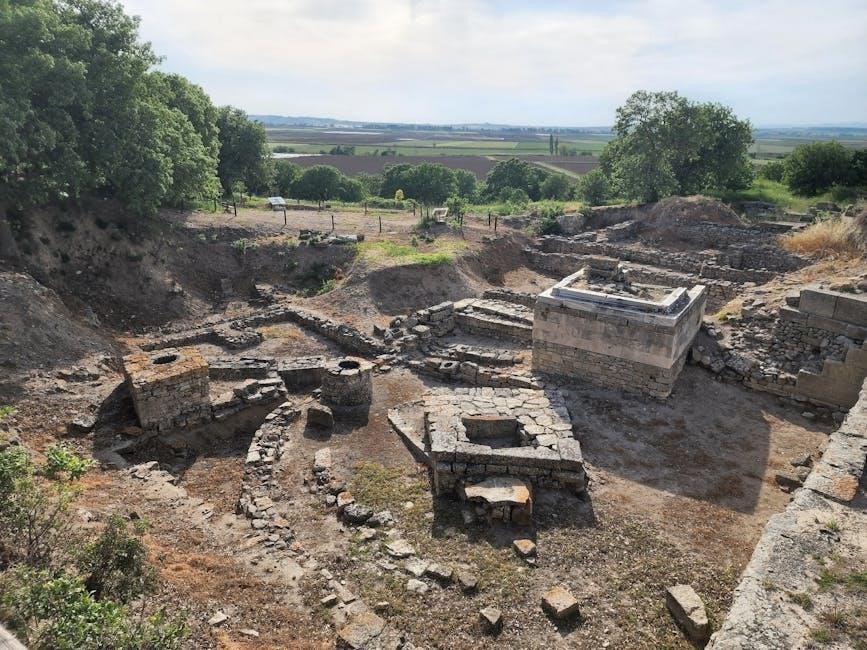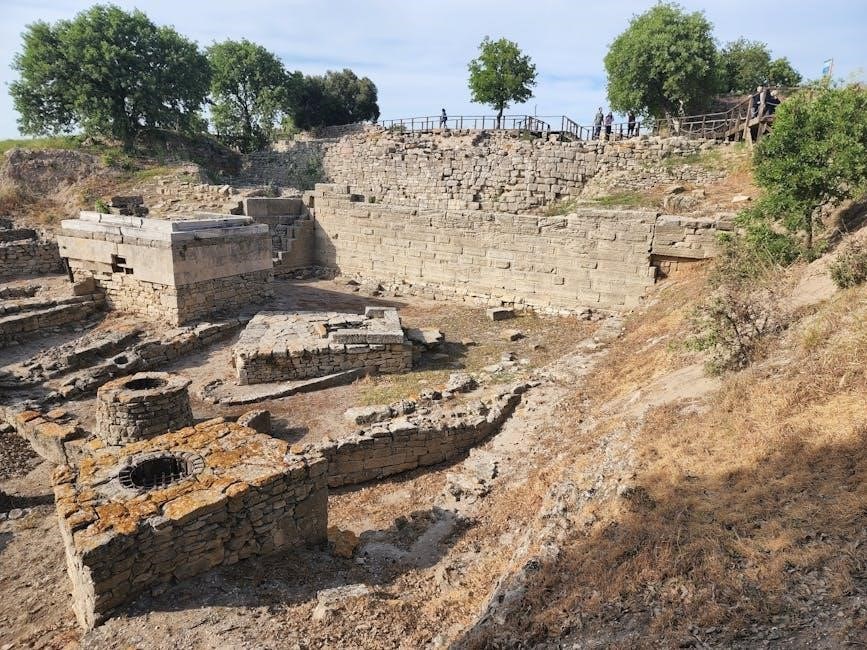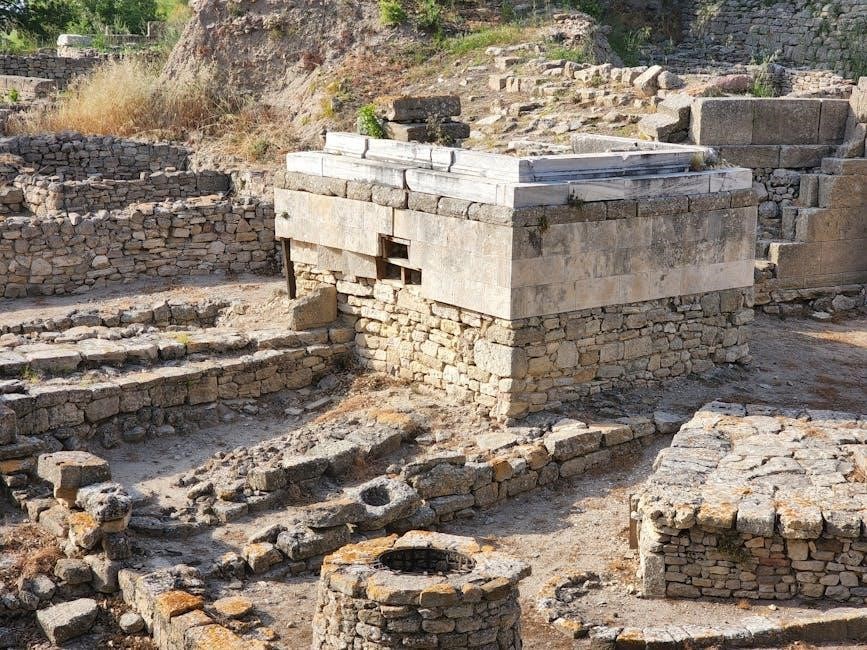Richmond Lattimore’s translation of the Iliad is renowned for its fidelity to Homer’s Greek text, balancing poetic style with clarity․ His work remains a gold standard for scholars and readers alike, offering a faithful yet accessible rendition of the epic poem․ The Iliad Lattimore PDF provides a digital gateway to this timeless masterpiece, preserving the original’s grandeur and complexity for modern audiences․
Overview of the Iliad

The Iliad is an ancient Greek epic poem attributed to Homer, recounting a pivotal episode during the Trojan War․ It focuses on the conflict between the Greek hero Achilles and King Agamemnon, exploring themes of honor, pride, and human suffering․ The poem is structured in dactylic hexameter, emphasizing its lyrical and rhythmic qualities․ Central to the narrative are the battles, divine interventions, and emotional struggles of legendary figures like Hector, Odysseus, and Achilles․ The Iliad is not only a war story but also a profound meditation on humanity, fate, and the complexities of heroism․ Its influence on literature and art spans millennia, making it a cornerstone of Western cultural heritage․
Who is Richmond Lattimore?
Richmond Lattimore (1906–1984) was a celebrated American poet, translator, and classical scholar․ Born in Pennsylvania, he developed a deep passion for classical languages and literature early in his academic career․ Lattimore is best known for his acclaimed translations of ancient Greek works, particularly Homer’s Iliad and Odyssey․ His translations are renowned for their fidelity to the original texts while maintaining a smooth, natural, and poetic style in English․ Lattimore’s work has been praised for making classical literature accessible to modern readers without compromising its grandeur or complexity․ His contributions to classical scholarship and translation remain unparalleled, leaving a lasting impact on the study and appreciation of ancient Greek literature․
The Significance of Lattimore’s Translation
Richmond Lattimore’s translation of the Iliad holds immense significance as a landmark work in classical scholarship․ His rendition is celebrated for its fidelity to Homer’s original Greek text, capturing the poetic grandeur and emotional depth of the epic․ Lattimore’s ability to preserve the dactylic hexameter’s rhythm while rendering it into natural, flowing English made the Iliad accessible to a broad audience․ His translation is widely regarded as a classic, balancing scholarly precision with literary artistry․ It has become a standard reference for both academic study and general readers, ensuring the timeless appeal of Homer’s masterpiece․ The PDF format further enhances its accessibility, making it easier for readers to engage with this seminal work․

Background of Lattimore’s Translation
Lattimore’s translation emerged from his deep academic expertise and poetic sensibility, aiming to preserve Homer’s original structure while making the epic accessible to modern readers․
Lattimore’s Academic Background and Expertise
Richmond Lattimore was a distinguished classicist and poet, renowned for his precise and lyrical translations of ancient Greek texts․ He studied at Dartmouth College and the University of Illinois, later earning his Ph․D․ in classical languages from the University of Chicago․ Lattimore’s expertise in Greek literature and poetry equipped him to capture the nuances of Homer’s epics․ His academic career included teaching positions at prominent universities, where he emphasized the importance of maintaining the original text’s integrity․ Lattimore’s deep understanding of meter, diction, and cultural context made him a leading figure in classical translation․ His work on the Iliad reflects both scholarly rigor and artistic flair, making his translation a benchmark for fidelity and readability․
Historical Context of the Translation
Richmond Lattimore’s translation of the Iliad was published in 1951, a period marked by renewed interest in classical literature․ The mid-20th century saw a surge in scholarly and public engagement with ancient texts, driven by post-WWII intellectual shifts․ Lattimore’s work emerged during a time when translators sought to balance fidelity to the original Greek with modern readability․ His translation was influenced by earlier renditions but broke ground by adhering closely to Homer’s structure and poetic style․ This approach resonated with an audience seeking authenticity without sacrificing accessibility․ The historical context highlights Lattimore’s role in bridging ancient and modern traditions, making the Iliad accessible to a broader audience while preserving its timeless essence․

Key Features of Lattimore’s Iliad
Lattimore’s translation is renowned for its fidelity to Homer’s Greek text, maintaining poetic style and rhythm while balancing readability․ His precise dactylic hexameter preserves the epic’s grandeur and emotional depth, ensuring the Iliad’s essence resonates with modern readers․
Fidelity to the Original Greek Text
Lattimore’s translation of the Iliad is celebrated for its meticulous fidelity to Homer’s original Greek text․ He prioritizes accuracy, preserving the poetic diction, syntax, and meter of the ancient epic while ensuring readability․ Lattimore’s dactylic hexameter closely mirrors the original rhythm, capturing the grandeur and intensity of Homer’s language․ His attention to detail extends to maintaining the nuances of character speech and divine interventions, which are central to the narrative․ This fidelity ensures that the PDF edition of Lattimore’s Iliad remains a reliable resource for scholars and readers seeking an authentic representation of Homer’s masterpiece, blending academic rigor with literary artistry․
Balance Between Fidelity and Readability
Lattimore’s translation of the Iliad masterfully balances fidelity to the original Greek text with readability for modern English readers․ While maintaining the poetic essence and structural integrity of Homer’s epic, Lattimore employs a clear, direct prose style that avoids unnecessary archaisms․ His dactylic hexameter mimics the original’s rhythm without sacrificing clarity, ensuring the text remains accessible․ This balance is crucial for preserving the historical and literary significance of the Iliad while engaging contemporary audiences․ The PDF edition of Lattimore’s translation retains this balance, offering both scholars and general readers a seamless experience of Homer’s masterpiece, blending academic precision with literary artistry․
Poetic Style and Rhythm
Lattimore’s translation of the Iliad is renowned for its poetic style and rhythmic fidelity to Homer’s original Greek․ He employs a dactylic hexameter, closely mirroring the meter of the ancient text, which gives the translation a grand, epic feel․ However, Lattimore’s use of English allows for a natural flow, avoiding the stiffness often found in metered translations․ His poetic style captures the emotional depth and complexity of Homer’s characters, while maintaining the dignity and gravity of the epic narrative․ The PDF edition preserves this rhythmic and stylistic integrity, making it a preferred choice for both scholars and readers seeking a poetic yet accurate rendition of the Iliad․

Comparisons with Other Translations
Lattimore’s Iliad is praised for its faithfulness to the Greek original, balancing poetic style with readability, distinguishing it from Fagles’ modern flair and Fitzgerald’s interpretive approach․
Lattimore vs․ Fagles
Lattimore’s translation of the Iliad is often compared to Robert Fagles’ version, with Lattimore praised for his strict adherence to the original Greek text․ Fagles, while accurate, employs a more contemporary and fluid style, making his version accessible to modern readers․ Lattimore’s focus on literal translation preserves Homer’s poetic structure, whereas Fagles prioritizes readability․ Scholars often prefer Lattimore for academic purposes due to its fidelity, while Fagles appeals to a broader audience․ Both translations are highly regarded but cater to different readerships, reflecting the balance between preserving the original’s essence and making it relatable to modern audiences․
Lattimore vs․ Fitzgerald
Lattimore’s translation is frequently contrasted with Robert Fitzgerald’s version of the Iliad․ Fitzgerald’s translation is celebrated for its poetic elegance and interpretive flair, often prioritizing literary artistry over strict fidelity to the Greek text․ In contrast, Lattimore adheres closely to Homer’s original structure and language, offering a more literal and scholarly rendering․ Fitzgerald’s version is often praised for its readability and emotional resonance, making it accessible to a wider audience․ Lattimore, however, remains a favorite among classicists for its precision and faithfulness to the source material․ Both translations highlight the tension between artistic interpretation and textual accuracy, catering to different reader preferences․
Other Notable Translations and Their Differences
Beyond Lattimore, other notable translations of the Iliad include those by Robert Fagles and Stephen Mitchell․ Fagles’ version is renowned for its vivid imagery and dramatic intensity, appealing to readers who appreciate a more engaging narrative style․ Mitchell’s translation emphasizes the poetic and lyrical aspects of Homer’s work, offering a contemporary twist while maintaining the epic’s grandeur․ These translations differ from Lattimore’s in their approach; while Lattimore prioritizes fidelity to the original Greek text, Fagles and Mitchell focus more on creating a compelling and accessible reading experience․ Each translator’s unique style caters to different audience preferences, whether scholarly accuracy or literary artistry is desired․ This diversity enriches the availability of the Iliad for various readers․

Criticisms and Controversies
Lattimore’s translation has faced criticism for its archaic language and strict fidelity, which some argue limits accessibility․ Debates persist over his handling of Homer’s nuanced phrases and themes․
Criticism of Gendered Language in Translations
Lattimore’s translation of the Iliad has drawn criticism for its handling of gendered language, reflecting the patriarchal norms of both the ancient Greek text and its mid-20th-century context․ Some scholars argue that Lattimore’s use of exclusively male pronouns and archaic gendered terms, such as “man” or “men,” can alienate modern readers and obscure the agency of female characters like Helen, Andromache, and Briseis․ Critics contend that while the translation mirrors the original’s patriarchal framework, it could have embraced more inclusive language without sacrificing fidelity․ This debate highlights the tension between preserving historical accuracy and adapting classical texts to contemporary sensibilities․
Debates Over Fidelity vs․ Artistic License
Lattimore’s Iliad translation is noted for its fidelity to Homer’s original text, preserving poetic structures and language․ His adherence to Greek syntax and meter maintains the work’s integrity․ Critics argue this strict fidelity may reduce readability and emotional resonance for modern audiences․ Supporters commend Lattimore for upholding Homer’s intent and nuances, balancing accuracy with accessibility․ This debate underscores the challenges in translating classical texts, emphasizing the balance between faithfulness and creativity․ Lattimore’s approach remains a standard in scholarship, reflecting the enduring relevance of his translation․

The Iliad Lattimore PDF
The Iliad Lattimore PDF is a notable version of Homer’s epic, offering a faithful translation with enhanced readability, making it accessible for modern readers while preserving the original’s poetic essence․
Availability and Accessibility
The Iliad Lattimore PDF is widely available through various online platforms, including major ebook retailers and academic databases․ Its digital format ensures easy access, making it convenient for readers worldwide․ Many universities and libraries offer the PDF for free or through subscription services, promoting accessibility for students and scholars․ The file is compatible with multiple devices, allowing readers to engage with the text on smartphones, tablets, or computers․ This accessibility has made Lattimore’s translation a popular choice for both casual readers and researchers․ Additionally, the PDF format preserves the poetic structure and formatting, ensuring an authentic reading experience while maintaining portability and ease of use․
Features of the PDF Edition
The Iliad Lattimore PDF edition offers a clean and readable format, preserving the poetic structure of the original text․ It includes clear typography and consistent pagination, ensuring a seamless reading experience․ The PDF often features annotations, footnotes, and an introduction that provide context and insights into Lattimore’s translation․ Many editions include bookmarks for easy navigation between books and key sections․ The text is searchable, allowing readers to quickly locate specific passages or themes․ The digital format also enables adjustable font sizes and night reading modes, enhancing accessibility․ Some versions may include supplementary materials, such as maps or a glossary, further enriching the reader’s understanding of the epic poem․
Benefits of the Digital Format
The Iliad Lattimore PDF offers unparalleled convenience and accessibility․ Readers can carry the entire text on their devices, eliminating the need for physical storage․ The digital format allows for easy highlighting, note-taking, and bookmarking, making it ideal for scholarly or casual reading․ Adjustable font sizes and night mode cater to individual preferences, ensuring comfort during extended reading sessions․ Search functionality enables quick access to specific lines or themes, while hyperlinks simplify navigation between sections․ Additionally, the PDF is environmentally friendly, reducing the need for paper․ Its portability and versatility make it a practical choice for both academic and personal use, enhancing the overall reading experience․

Themes and Analysis
The Iliad Lattimore PDF explores themes like honor, pride, and mortality, offering deep insights into human conflict and emotional complexity through its vivid narrative and poetic prose․
Major Themes in the Iliad
The Iliad Lattimore PDF delves into universal themes such as honor, pride, and the human cost of war․ Richmond Lattimore’s translation vividly captures the complexities of Achilles’ rage and the tragic inevitability of fate․ The epic explores the duality of heroism, juxtaposing Achilles’ divine fury with Hector’s mortal nobility․ Themes of grief, revenge, and the fleeting nature of human life are central, resonating deeply through Lattimore’s poetic prose․ The struggle between individual pride and collective duty is a recurring motif, while the role of the gods highlights the interplay between divine will and human agency․ Lattimore’s rendition preserves the emotional depth and philosophical richness of Homer’s original work, making these themes timeless and accessible to modern readers․
Character Analysis: Achilles, Hector, and Others
In the Iliad Lattimore PDF, Achilles emerges as a complex, brooding figure, driven by rage and a deep sense of honor․ His vulnerability, particularly in his relationship with Patroclus, is poignantly rendered by Lattimore․ Hector, the noble Trojan prince, embodies duty and compassion, contrasting sharply with Achilles’ fury․ Lattimore’s translation captures the tragic tension between these two warriors․ Other characters, such as Odysseus and Priam, add layers of wisdom and pathos, while the gods’ interventions highlight the interplay of divine and human wills․ Lattimore’s precise language ensures that the characters’ emotions and motivations resonate clearly, preserving the epic’s emotional depth and complexity․
Structural and Narrative Techniques
The Iliad Lattimore PDF preserves Homer’s masterful use of non-linear narrative, with flashbacks and divine interventions enriching the storytelling․ Lattimore’s translation maintains the epic’s structural integrity, emphasizing the cyclic nature of war and fate․ The poem’s focus on specific episodes, such as the wrath of Achilles, allows for deep exploration of human emotion and conflict․ Dramatic irony, particularly in the gods’ foresight of events, heightens tension․ Lattimore’s rendition also highlights the interplay between dialogue and descriptive passages, with characters’ speeches revealing their motivations and the broader themes of honor, pride, and mortality․ The translation’s clarity ensures these narrative techniques remain accessible and impactful, resonating with modern readers while staying true to Homer’s original vision․

Reception and Impact
Lattimore’s Iliad has received widespread scholarly acclaim for its fidelity and poetic grace, influencing classical studies and remaining a popular choice for readers seeking an authentic representation of Homer’s epic․
Scholarly Reception of Lattimore’s Translation
Scholars have widely praised Richmond Lattimore’s translation of the Iliad for its meticulous fidelity to Homer’s original Greek text while maintaining a poetic and readable English style․ His attention to detail and commitment to preserving the epic’s meter and tone have made it a benchmark for classical translations․ Academics often commend Lattimore’s ability to balance linguistic accuracy with literary artistry, ensuring the translation remains accessible to both students and general readers․ The PDF edition of Lattimore’s Iliad has further enhanced its utility in scholarly contexts, offering a reliable and portable resource for teaching and research․ Its clarity and faithfulness to the source have solidified its place as a foundational text in classical studies․
Reader Feedback and Popularity
Richmond Lattimore’s translation of the Iliad has garnered widespread acclaim from readers, who praise its clarity, poetic depth, and faithfulness to Homer’s original work․ The PDF version has proven particularly popular due to its accessibility and readability on digital devices․ Many readers appreciate how Lattimore balances scholarly precision with lyrical prose, making the epic accessible to both casual readers and students․ The translation’s ability to evoke the grandeur and emotional complexity of the original text has resonated with audiences, fostering a deeper connection to the ancient narrative․ Its popularity endures, with the PDF format enhancing its convenience and appeal for modern readers seeking a timeless classic in a modern medium․
Cultural and Literary Impact
Richmond Lattimore’s translation of the Iliad has left an indelible mark on classical scholarship and literature․ His work is widely regarded as a benchmark for fidelity to Homer’s original text while maintaining poetic elegance․ The PDF version has further amplified its reach, ensuring that this masterpiece remains accessible to a broad audience․ Lattimore’s translation has influenced countless scholars, writers, and thinkers, shaping how modern readers engage with ancient Greek literature․ Its cultural impact is evident in its enduring presence in academic curricula and literary discussions, bridging the gap between antiquity and contemporary readership․ The Iliad Lattimore PDF continues to inspire new generations, solidifying its place as a cornerstone of literary heritage․

Resources and Further Reading
The Iliad Lattimore PDF is widely available on academic platforms, offering supplementary guides and cross-references to enhance understanding of Homer’s epic․
Commentaries and Guides on Lattimore’s Iliad
Scholars and readers alike can benefit from numerous commentaries and guides analyzing Lattimore’s translation of the Iliad․ These resources, often available in PDF formats, provide in-depth analyses of Lattimore’s linguistic choices, his fidelity to the original Greek, and his poetic style․ Many academic institutions and literary websites offer downloadable guides that explore the historical and cultural context of the epic, alongside Lattimore’s interpretative decisions․ These materials are particularly useful for students and researchers, offering insights into the nuances of Homer’s text and Lattimore’s translation․ They often include comparative studies, thematic breakdowns, and discussions of the translation’s reception, making them invaluable for a deeper understanding of the Iliad․
Other Works by Lattimore
Richmond Lattimore, renowned for his Iliad translation, was a prolific scholar and translator with a diverse body of work․ Beyond the Iliad, he translated Homer’s Odyssey and works by Aeschylus, Sophocles, and Euripides․ Lattimore also authored The Story of the Iliad, a critical analysis of the epic poem․ His translations of modern poets, such as C․P․ Cavafy, highlight his versatility․ Additionally, Lattimore wrote The Trojan Women, a poetic reinterpretation of Euripides’ play․ These works demonstrate his mastery of classical literature and poetic expression․ Lattimore’s contributions extend beyond translation, offering insights into ancient and modern literary traditions, further enriching the study of the Iliad and its cultural significance․
Recommended Reading for Deeper Understanding
by Eric H․ Cline, enhance understanding of the epic’s background․ These resources collectively deepen one’s appreciation of Lattimore’s Iliad and its timeless themes․
Richmond Lattimore’s translation of the Iliad stands as a landmark, blending fidelity and readability․ His work preserves Homer’s epic, ensuring its timeless themes endure․ The Iliad Lattimore PDF remains a vital resource for scholars and readers, cementing its place in classical literature․
Final Thoughts on Lattimore’s Contribution
Richmond Lattimore’s translation of the Iliad is a masterful achievement, blending scholarly precision with poetic grace․ His work remains a cornerstone of classical literature, offering readers unparalleled fidelity to Homer’s original vision while maintaining readability․ The Iliad Lattimore PDF has become an essential resource, providing accessible insight into ancient Greek epic poetry․ Lattimore’s commitment to preserving the nuances of the original text ensures that the timeless themes of honor, humanity, and conflict continue to resonate with modern audiences․ His legacy endures as a bridge between antiquity and contemporary readers, solidifying his place in the history of classical scholarship and literature․
The Timeless Appeal of the Iliad
The Iliad remains a timeless masterpiece, captivating audiences for millennia with its universal themes of human emotion, conflict, and heroism․ Its exploration of pride, grief, and honor resonates across cultures and eras, transcending its ancient origins․ The epic’s vivid portrayal of war’s brutality and the complexity of its characters, such as Achilles and Hector, continues to inspire reflection on humanity’s enduring struggles․ Richmond Lattimore’s translation, available as the Iliad Lattimore PDF, preserves the poetic grandeur and emotional depth of Homer’s original work, ensuring its relevance for modern readers․ The text’s accessibility in digital formats furthers its timeless appeal, introducing it to new generations․
Future of Classical Translations
The future of classical translations, as seen with the Iliad Lattimore PDF, lies in blending fidelity with modern accessibility․ Digital formats enable wider dissemination, ensuring ancient works reach global audiences․ Translators may increasingly adopt innovative methods to preserve poetic nuances while enhancing readability․ The rise of collaborative projects and technological tools, such as AI-assisted translation, could further refine the process․ Additionally, multimedia enhancements, like embedded commentaries or audio versions, could deepen engagement․ As classical texts evolve in format, they remain vital, offering timeless insights into human experience․ The Iliad Lattimore PDF exemplifies how digital media can breathe new life into ancient masterpieces, ensuring their enduring relevance․

